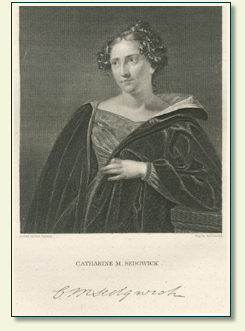|
|
|
|
|
|
|
As a child in Stockbridge, Massachusetts, Catharine
Sedgwick took much of the responsibility for running her family's household,
as her mother suffered from periods of insanity and invalidism. Religious and
introspective, she railed against the Calvinist doctrine with which she was
raised and joined the Unitarian church in 1821. An anti-Calvinist tract she
began writing while living with her brothers in Choosing to remain unmarried throughout her life, Catharine Sedgwick turned down half a dozen marriage proposals, and her final novel, Married or Single?, defends the status of "old maids." While her stories portray the dignity and needs of both single and married women, she eschewed involvement with the women's rights movement and maintained that women could secure social and political rights without organized agitation. In 1846, Edgar Allan Poe described her in his “The Literati of New York City. No. V,” in Godey’s Lady’s Book, v. 33, p. 131-132: She
is about the medium height, perhaps a little below it. Her forehead is an
unusually fine one; nose of a slightly Roman curve; eyes dark and piercing;
mouth well-formed and remarkably pleasant in its expression. The portrait in “Graham's
Magazine” is by no means a likeness, and, although the hair is
represented as curled, (Miss Sedgwick at present wears a cap—at least,
most usually,) gives her the air of being much older than she is.
Other portraits appear in:
|
|
|
|


